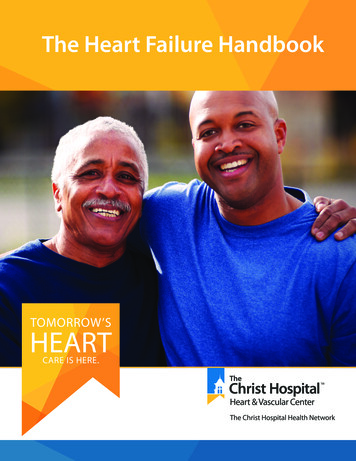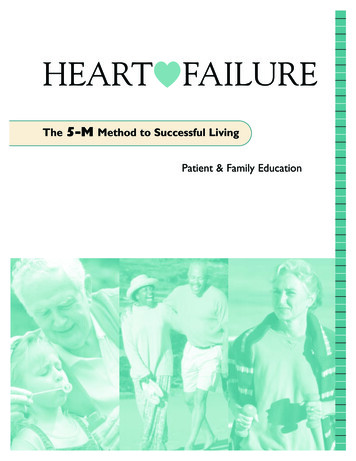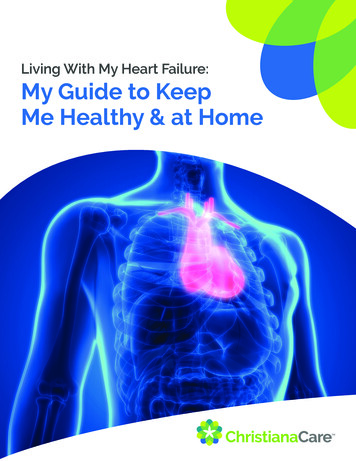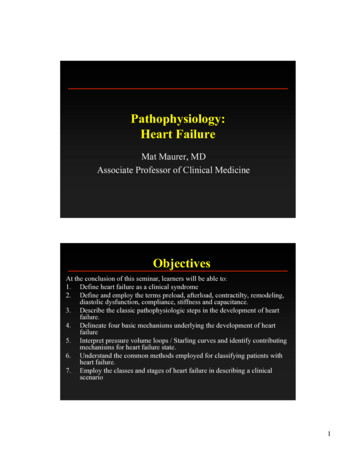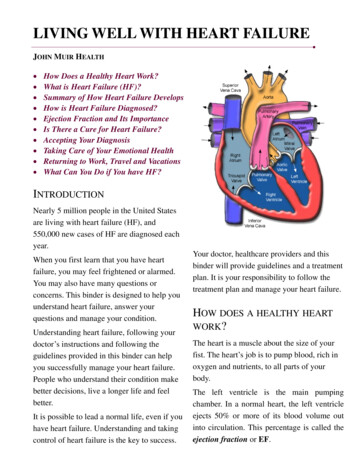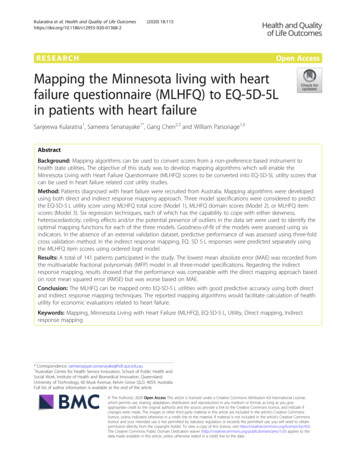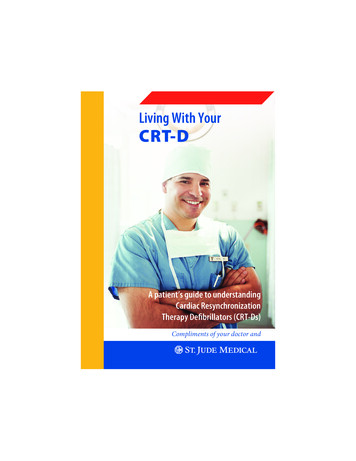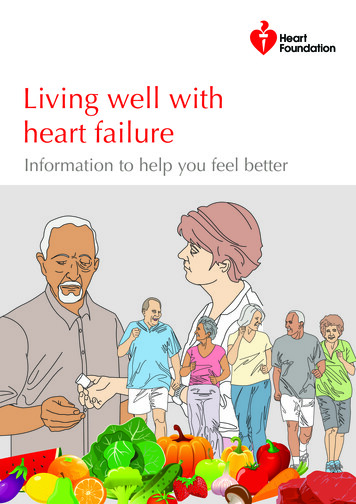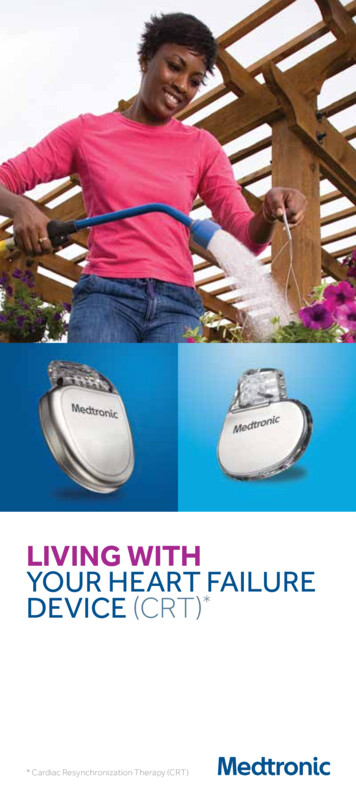
Transcription
LIVING WITHYOUR HEART FAILUREDEVICE (CRT)** Cardiac Resynchronization Therapy (CRT)
TOGETHER,HELPING YOULEAD AFULLER LIFE.If you or someone you love has beendiagnosed with heart failure, this bookletcan help you understand your heartcondition and treatment options. Itis designed to provide you with basicinformation about heart failure and cardiacresynchronization therapy (CRT) devices,including what to expect before and afteryou have a CRT device implanted.Ask your doctor about your unique medicalcondition and therapy management.WHAT ISHEART FAILURE?Heart failure is a condition where the heartmuscle is weakened and is not able toefficiently pump blood.The term heart failure does not mean yourheart has stopped pumping; rather, yourheart muscle is not able to pump enoughblood to meet your body’s needs. As aresult, you may feel tired, lack energy,experience shortness of breath and noticeexcess fluid collecting in your body.The heart is a fist-sized organ that actsas a pump to send oxygen-rich bloodthroughout the body. In a healthy heart,each chamber contracts (squeezes) in acoordinated effort—the upper chambers(atria) of the heart contract first, thenthe lower chambers (ventricles) contract.These coordinated contractions circulateblood between the lungs and heart andto the rest of the body. If the heart is notbeating in a coordinated fashion, then thebody will not receive an adequate amountof blood to function properly.HEALTHYHEARTHEARTFAILUREChambers enlargeto handle increased fluidWalls may thicken to handlethe increased strainAngelinaCRT-D RecipientDuring heart failure, the heart attempts to compensate for lostpumping power, which may change its shape and result in anuncoordinated (or unsynchronized) and inefficient heartbeat.
SYMPTOMS OFHEART FAILURECAUSES OFHEART FAILUREHeart failure is a progressive condition,meaning it will gradually worsen. At firstyou might not experience any symptoms,but over time your heart’s pumping abilitywill continue to weaken and you mayexperience some or all of the followingsymptoms:Heart failure usually develops slowlyafter an injury to the heart. There is nosingle cause, and sometimes the causeis unknown. Some of the most commoncauses of heart failure are:§ Chronic lack of energy§ Difficulty sleeping at night due tobreathing problems§ Confusion and/or impaired memory§ Increased urination at night§ Swelling of feet and legs§ Shortness of breath§ Swollen or tender abdomen withloss of appetite§ Cough with frothy sputum§ Previous heart attack(myocardial infarction)§ Coronary artery disease§ High blood pressure(hypertension)§ Heart valve disease§ Infection of the heart(myocarditis)§ Congenital heart disease(condition you were born with)§ Endocarditis(infection of the heart’s inner lining)§ Diabetes(the body does not produce orproperly use insulin)
RISKS OF APOORLYPUMPINGHEARTA weakened heart muscle must work harderto pump blood to the body. This may causethe heart to beat faster, which can lead todangerously fast or irregular heart rhythms.These abnormal heart rhythms can lead to acondition called Sudden Cardiac Arrest (SCA).What is SCA?SCA typically occurs when an electrical problemwith the heart triggers a dangerously fast heartrhythm that causes the heart to quiver ratherthan contract or pump. When the heart stopspumping blood, oxygen cannot reach the bodyand brain. If not treated immediately, SCA canbe fatal. The most effective way to treat SCAis through defibrillation.1 Defibrillation involvesdelivering an electrical shock to your heart torestore a normal heartbeat. To survive an SCAevent, you must receive defibrillation withinten minutes.2 Only about 5% of people surviveSCA, because defibrillation was not deliveredwithin this critical time frame.2Who is at risk of sudden cardiac arrest?Generally, sudden cardiac arrest strikeswithout warning. People who are at a higherrisk for SCA include2:§ Those who have had a heart attack§ Heart failure patients§ Survivors of a previous SCA or those whohave a family member who has had anSCA event§ People with a low ejection fractionEF number: a number you should knowEF stands for “ejection fraction.” It is thepercentage of blood that is pumped out ofthe heart with each heartbeat. Your doctordetermines how well your heart is pumping basedon your EF number.Your EF number can change over time. It isimportant for you and your doctor to check yourEF regularly.Chart of typical EF ranges2:50–75%Heart’spumpingability isNORMAL36–49%Heart’spumpingability is ELOWBNORMAL35% & BelowHeart’spumpingability isLOWPeople with a low EF—35% or below—are at anincreased risk for SCA.3A healthy heart has an EF between 50% and 75%.This indicates the heart is pumping well and ableto deliver enough blood to the body and brain.Even a healthy heart does not pump 100% ofblood out of the heart during each beat—someblood always remains in the heart.How is EF measured?The most common way to measure EF is with anechocardiogram. This test is usually performed ina doctor’s office or hospital’s diagnostic area.Treating heart failureHeart failure is a progressive condition. Yourdoctor may prescribe a variety of treatmentoptions that may slow the progression of thedisease, strengthen your heart and improve yourquality of life. Some of these treatments mayinclude medications, lifestyle changes, exercise,device therapy or a combination of these. Onlyyour doctor can determine which option is rightfor you.
WHAT ISA CARDIACRESYNCHRONIZATIONTHERAPYDEVICE?HOW DOESA CARDIACRESYNCHRONIZATIONTHERAPY DEVICEWORK?When people refer to an implantable cardiacresynchronization therapy (CRT) device, they areactually discussing the system—the CRT device andthe leads.A cardiac resynchronization therapy device isdesigned to monitor your heart rhythm 24 hoursa day. It sends electrical pulses to pace the lowerchambers of your heart to help them beat in amore coordinated rhythm. This coordinating or“resynchronization” therapy improves the heart’sability to pump blood and oxygen more efficiently tothe body. Your doctor will program the CRT device todeliver the most effective therapies for your specificheart condition.§A CRT device is a device implanted under the skin,typically just below the collarbone. The devicedelivers therapies to coordinate the heart’s pumpingaction and treats fast, irregular or slow heartrhythms depending on the type of CRT device. Thisdevice may also be referred to as a heart failuredevice, biventricular device, three-lead CRT device,CRT-P (pacemaker) or a CRT-D (defibrillator).§L eads are thin, soft insulated wires about the sizeof a spaghetti noodle. The leads carry the electricalimpulse from the CRT device to your heart andrelay information about the heart’s activity back tothe CRT device.In response to abnormal heart rhythms,a CRT heart device may also provide thefollowing therapies:§P acing therapy for slow heart rhythms—electricalimpulses are delivered to the heart when the heart’sown rhythm is too slow or irregular§D efibrillation therapies for fast or irregular heartrhythms—a shock therapy is delivered to the heartto interrupt fast heart rhythms and restore a normalheart rateThere are two types of CRT devices—a CRTpacemaker (CRT-P) and a CRT defibrillator (CRT-D).CRT-D devices, like all defibrillators, have a pacemakerfunction in them. Both devices help to coordinate theheart’s pumping action and deliver pacing therapy for aslow heart rate. However, the CRT-D can also treat fastheart rhythms.All cardiac resynchronization devices are designedto use three leads. One lead is placed inside theright atrium, another lead is placed inside the rightventricle and the third lead is placed inside a vein onthe outside of the left ventricle.
Cardiac Resynchronization TherapyDefibrillator (CRT-D) and Leads(actual size)Cardiac Resynchronization TherapyPacing (CRT-P) and Leads(actual size)
GETTING ACRT DEVICEIMPLANTEDMRISCAN ACCESSThe procedure to implant a CRT devicedoes not require open heart surgery, andmost people go home within 24 hours.Before the surgery, medication may begiven to make you sleepy and comfortable.Generally, the procedure is performedunder local anesthesia.Traditionally, most CRTs are not consideredsafe in an MRI environment because theMRI could change the settings, temporarilyaffect the normal operation of orpotentially damage the CRT.The general steps of an implantprocedure include:§ A small incision, approximately two tofour inches long, will be made in the upperchest area, just below your collarbone§ Three leads will be guided through avein into your heart, and the leads will beconnected to the CRT device§ The CRT device settings will beprogrammed, and the device will betested to ensure it is working properly tomeet your medical needs§ The CRT device will be inserted beneathyour skin, and the incision in your chestwill be closedTake comfort in knowing that Medtronichas CRT-D systems that are FDA approvedfor use in the MRI environment. The CRT-Dsystem has a unique design developed sothat under specific conditions, patientsmay safely undergo MRI scans. Talk to yourdoctor about the CRT-D options availableto you, including a device that may allowyou access to an MRI in the future.
FOLLOW-UPCARE &REMOTEMONITORINGFollow-up appointments enable the CRT to bethoroughly checked. During these check-ups,your doctor may:§ Monitor the battery status of the CRT§ Check the leads to determine how they areworking with the CRT and your heart§ Review your CRT settings to ensure theyare programmed appropriately to yourmedical needs§ Make programming adjustments to your CRTIn addition to these check-ups with yourdoctor, your clinic or practice may chooseto have your CRT checked through remotemonitoring.Today millions of people all over the worldbenefit from remote monitoring of their heartdevices. Remote monitoring of your Medtronicheart device allows you to send deviceinformation to your doctor or clinic througha small monitor. Your clinic can review thisinformation on the secure CareLink Networkand take appropriate action.Medtronic patient monitors are easy to useand offer convenient connection options—Wi-Fi, Internet connection or cellular signal —depending on your specific monitor.To find out if remote monitoring is rightfor you, please talk to your doctor.PATIENTTESTIMONIALS“With remotemonitoring, you’remore connected withyour clinic. It’s easy.It’s reliable. It’s just agreat tool and a greatasset to your medicalcare—and makingsure you’re connectedwith your doctor.”Robbie(Cardiac Device Patient)“Why wouldn’t youdo something likethis (remotemonitoring)?It’s convenient.It’s accurate.It’s not intrusive.”Doug(Cardiac Device Patient)
LIVING WITHA CRT DEVICEMany people with a CRT device resume theirnormal daily activities after recovering fromthe implant procedure. There may be certainsituations your doctor will ask you to avoid.Discuss your activity and lifestyle goals withyour doctor and develop a plan that works bestfor you.held massagers can temporarily affect theoperation of your CRT device. Therefore, itis recommended you keep items containingmagnets at least six inches away from yourimplanted CRT device. We do not recommendthe use of magnetic mattress pads and pillowsbecause it is difficult to maintain a six-inchdistance when using these items.FREQUENTLYASKEDQUESTIONSWill I be able to travel?Can I use a cell phone?Yes. When talking on a cell phone keepthe phone’s antenna six inches away fromyour CRT device, and use the phone onthe ear opposite your CRT device. We alsorecommend you avoid placing the cell phonein a pocket near your CRT device.Are household appliances safeto use?Yes. Most household appliances are safe to useas long as they are properly maintained and ingood working order. This includes microwaveovens, major appliances, electric blankets andheating pads.Will magnets affect my device?Items that contain magnets, such as magnetictherapy products, stereo speakers and hand-Given the short duration of security screening,it is unlikely that your Medtronic CRT device willbe affected by metal detectors (walk-througharchways and hand-held wands) or full bodyimaging scanners (also called millimeter wavescanners and 3D imaging scanners) such asthose found in airports, courthouses and jails.To minimize the risk of temporary interferencewith your CRT device while going through thesecurity screening process, avoid touchingmetal surfaces around any screeningequipment. Do not stop or linger in a walkthrough archway; simply walk through thearchway at a normal pace. If a hand-held wandis used, ask the security operator not to hold itover your CRT device and not to wave it backand forth over your CRT device. You may alsorequest a hand search as an alternative.If you have concerns about these securityscreening methods, show your device ID card,request alternative screening and then followthe instructions of the security personnel.
EDUCATIONALSERVICESFOR PATIENTSMedtronic Patient ServicesIf you have a Medtronic cardiac deviceand want to learn more or have questionsabout living with an implanted CRT device,please contact Medtronic Patient Servicesat 1 (800) 551-5544, ext. 41835. OurPatient Services Specialists are available toassist you, Monday-Friday from 8 a.m. to5 p.m. Central time.Medtronic.comThe Medtronic website includes in-depthinformation on heart conditions andtreatment options for patients and theircaregivers. Our interactive website allowsyou to take assessments, view video, readpatient stories and link to other resources.Visit us online at www.medtronic.com.References1 Zipes DP, Roberts D. Results of the international study of theimplantable pacemaker cardioverter-defibrillator. A comparisonof epicardial and endocardial lead systems. The PacemakerCardioverter-Defibrillator Investigators. Circulation. July 1,1995;92(1):59-65.2 American Heart Association. Statistical fact sheet. Suddendeath from cardiac arrest. www.americanheart.org.3 Epstein AE, DiMarco JP, Ellenbogen KA, et al. ACC/AHA/HRS2008 Guidelines for device-based therapy of cardiac rhythmabnormalities [corrections appear at J Am Coll Cardiol. April 21,2009;53(16):1473. J Am Coll Cardiol. January 6, 2009;53(1):147.]. J Am Coll Cardiol. May 27, 2008;51(21):e1-62.Brief StatementAdditional Device InformationA cardiac resynchronization therapy (CRT) implantablecardioverter defibrillator (ICD) system delivers therapies to treatpatients who may benefit from synchronizing the pumping ofthe heart chambers. A CRT ICD also delivers therapies to treatpatients with heart rhythm disorders or who are at significant riskof developing heart rhythm disorders. A CRT ICD is placed insideyour body and works automatically.An implantable CRT pacemaker system relieves symptoms ofheart rhythm disturbances. They do this by restoring normalheart rates. A normal heart rate provides your body with theproper amount of blood circulation. The pacemaker system isintended for patients who need rate-adaptive pacing or chronicpacing or for patients who may benefit from synchronizing thepumping of the heart chambers.Risks associated with these implantable device systemsinclude, but are not limited to, infection at the surgical siteand/or sensitivity to the device material, failure to delivertherapy when it is needed, or receiving extra therapy whenit is not needed. After receiving a CRT ICD system, you willhave limitations with magnetic and electromagnetic radiation,electric or gas-powered appliances, and tools with which youare allowed to be in contact.Treatment with these implantable device systems isprescribed by your physician. This treatment is not foreveryone. Please talk to your doctor to see if it is right for you.Your physician should discuss all potential benefits and riskswith you. Although many patients benefit from the use of thistreatment, results may vary. For further information, pleasecall the Medtronic toll-free number at 1 (800) 551-5544(8:00 a.m. to 5:00 p.m., Monday-Friday, Central time) or see theMedtronic website at www.medtronic.com.Medtronic CareLink Monitor/CareLink NetworkAdditional Device InformationThe CareLink Monitor is a prescription product indicated for usein the transfer of patient data from some Medtronic implantablecardiac devices based on physician instructions and as describedin the product manual. This product is not a substitute forappropriate medical attention in the event of an emergency andshould only be used as directed by a physician. CareLink Serviceis currently available in the continental United States, Alaska, andHawaii.The CareLink Service is prescribed by your physician. Thisservice is not for everyone. Please talk to your doctor to seeif it is right for you. Your physician should discuss all potentialbenefits and risks with you. Although many patients benefit fromthe use of this service, results may vary. For further information,please call the Medtronic toll-free number at 1 (800) 551-5544(Monday-Friday, 8:00 a.m. to 5:00 p.m., Central time) or see theMedtronic website at www.medtronic.com.Caution: Federal law (USA) restricts these devices to sale by oron the order of a physician.
Patient ServicesMedtronic8200 Coral Sea St. NE MVS14Mounds View, MN 55112Patient toll-free line:1 (800) 551-5544Fax: (763) 367-58098:00 am to 5:00 pm CT Mon.-Fri.Medtronic710 Medtronic ParkwayMinneapolis, MN 55432-5604USATel: (763) 514-4000Fax: (763) 514-4879medtronic.comToll-free: 1 (800) 328-2518(24-hour technical support forphysicians and medical professionals)UC201102811c EN Medtronic 2015.Minneapolis, MN. All Rights Reserved.Printed in USA. 11/2015
Heart failure usually develops slowly after an injury to the heart. There is no single cause, and sometimes the cause is unknown. Some of the most common causes of heart failure are: § Previous heart attack (myocardial infarction) § Coronary artery disease § High blood pressure (hypertension) § Heart valve disease § Infection of the heart
